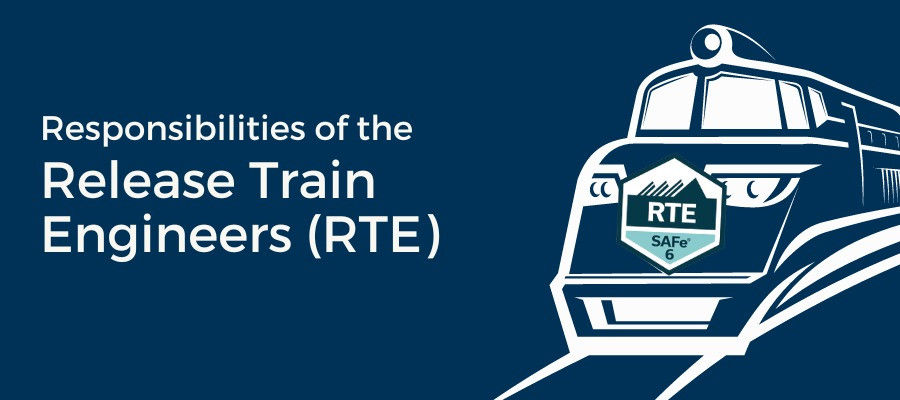Responsibilities of the Release Train Engineers (RTE)

The software development industry is constantly evolving, giving rise to novel approaches for creating, releasing, and deploying software solutions. Alongside these emerging techniques, new job positions and descriptions are also appearing.
Have you ever wondered how large-scale software development enterprises, comprising numerous employees and teams, manage to deliver software Releases seamlessly and on time? The answer lies in a straightforward solution: many enterprises leverage the Release train, a technique provided by the Scaled Agile Framework (SAFe).
In this article, we will delve into the responsibilities of a Release train engineer. We will explore the necessity of this role, its significance, and the essential qualities and skills required to undertake it. However, before we delve into the details, let us first examine the fundamental concept of the Release train itself.
Who is a Release Train Engineer?
A Release train engineer (RTE) assumes the pivotal position of both driver and chief orchestrator within the Agile Release Train (ART). As a servant leader, the RTE leverages extensive knowledge of the Agile framework and SAFe to navigate the ART's course, aiming to optimize the organization's value delivery output. Their responsibilities encompass Coaching teams, mitigating risks, engaging stakeholders, and, above all, ensuring the successful attainment of project goals.
A train that falls short of its performance potential is no different from a stationary entity. Recognizing this, the RTE diligently ensures that the Agile Release train functions operate efficiently, maximizing the delivery of valuable services.
Exploring the Responsibilities of a Release Train Engineer
- Managing Personnel
One of the primary responsibilities of a Release train engineer (RTE) is to engage with every team within the Agile Release train actively. They are crucial in supporting individuals and groups to enhance their capabilities, contributing more significant value to the organization. This involves fostering a continuous Learning and improvement culture through training initiatives, establishing efficient workflows, and cultivating an environment conducive to positive team dynamics and productivity.
- Program Increment (PI) Planning
The RTE is entrusted with creating the program Increment chart for the project. Program Increments form a fundamental aspect of the Agile framework, serving as timeboxes dedicated to delivering Incremental value within the ART. By carefully planning program Increments, the RTE ensures that teams adhere to set deadlines and successfully provide functioning and tested software systems. They must consider various factors that may impact timelines and make necessary adjustments to the schedule.
- Team Development
The RTE is responsible for providing training and guidance to the entire Release train, imparting best practices for delivering increased value. This can be accomplished through Coaching, mentoring, and serving as a role model by exemplifying Agile principles in action.
- Overseeing the Release Train
As the "driver" of the train, the RTE assumes a general oversight role, monitoring and supervising the activities of the Release train. This includes observing and documenting the achievements of the teams, analyzing the train's performance at the end of each journey, and identifying areas for improvement. The RTE creates a roadmap to enhance future activities and outcomes by reflecting on past actions and results, ensuring continuous progress and success.
Day-to-Day Tasks of a Release Train Engineer
Being a Release train engineer involves a dynamic set of daily tasks. Let's delve into the typical responsibilities and activities performed by an RTE:
Fostering Collaboration: The RTE is vital in promoting effective collaboration among teams and various departments within the organization. They facilitate an environment that encourages communication, cooperation, and synergy.
Synchronization Meetings: The RTE organizes regular synchronization meetings, bringing together key stakeholders such as product managers, Product Owners, and Scrum Masters from the SAFe framework. These meetings ensure alignment and coordination across teams and enable efficient progress tracking.
Stakeholder Communication: The RTE maintains ongoing communication with stakeholders to ensure that the organization's vision and processes align effectively. They act as a bridge between the teams and stakeholders, facilitating clear understanding and feedback loops.
System and Solution Demos: The RTE oversees the organization and execution of system and solution demos. These demos provide a platform for teams to showcase their progress, validate functionality, and gather valuable feedback.
Agile Budget Management: The RTE ensures effective financial management within the approved Agile budget. They work within allocated resources, making informed decisions to optimize value delivery while adhering to budgetary constraints.
User Experience (UX) Focus: The RTE assists teams in setting up a user experience approach, emphasizing the importance of gathering user feedback. They help establish practices that enhance the user experience and ensure continuous improvement.
Wrapping up
The role of a Release train engineer holds significant transformative power in enhancing the service value delivery of an organization. A skilled and proficient RTE becomes a valuable asset to a firm, providing guidance, Coaching, and support to team leaders, Scrum Masters, and the entire team.
By collaborating closely with the members of the Agile governance trio, including product managers and system architects, the RTE strengthens the organization's capacity for value delivery.
Reference
- https://www.enov8.com/blog/what-is-the-role-of-a-release-train-engineer/



